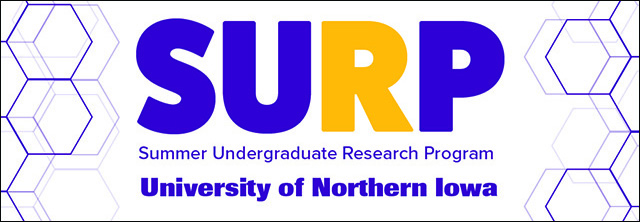
2022 Summer Undergraduate Research Program (SURP) Symposium
Location
ScholarSpace, Rod Library, University of Northern Iowa
Presentation Type
Open Access Poster Presentation
Document Type
poster
Keywords
Lithium mines and mining;
Abstract
Fast lithium isolation from water partly containing lithium ions would be an improvement over the current method of obtaining lithium in lithium mining water operations. The aminimide functional group can be used to selectively bind to lithium cations to extract lithium from brine. To characterize this uptake, the concentration of water containing lithium was measured with atomic absorption spectroscopy before and after the solution has been exposed to a polymer with the aminimide functional group. Three different polymers were used: trimethyl EGDM polymer, trimethyl TMPTA polymer, and the triethyl TMPTA polymer. Of the three, the trimethyl TMPTA polymer seemed to perform the best.
Start Date
29-7-2022 11:00 AM
End Date
29-7-2022 1:30 PM
Event Host
Summer Undergraduate Research Program, University of Northern Iowa
Faculty Advisor
Martin Chin
Department
Department of Chemistry and Biochemistry
Copyright
©2022 Austin Heidbreder and Dr. Martin Chin
File Format
application/pdf
Recommended Citation
Heidbreder, Austin and Chin, Martin Ph.D., "Using an Aminimide Polymer to Extract Lithium from a Brine Solution" (2022). Summer Undergraduate Research Program (SURP) Symposium. 34.
https://scholarworks.uni.edu/surp/2022/all/34
Using an Aminimide Polymer to Extract Lithium from a Brine Solution
ScholarSpace, Rod Library, University of Northern Iowa
Fast lithium isolation from water partly containing lithium ions would be an improvement over the current method of obtaining lithium in lithium mining water operations. The aminimide functional group can be used to selectively bind to lithium cations to extract lithium from brine. To characterize this uptake, the concentration of water containing lithium was measured with atomic absorption spectroscopy before and after the solution has been exposed to a polymer with the aminimide functional group. Three different polymers were used: trimethyl EGDM polymer, trimethyl TMPTA polymer, and the triethyl TMPTA polymer. Of the three, the trimethyl TMPTA polymer seemed to perform the best.


